
Features
Crop Protection
Flowers
Vegetables
Meet the new thrips on the block
Greenhouses aren’t just dealing with Western flower thrips anymore. Here’s how you can tell your thrips apart.
March 3, 2020 By Dr. Sarah Jandricic, Ashley Summerfield, Dr. Rose Buitenhuis and Dr. Cynthia Scott-Dupree
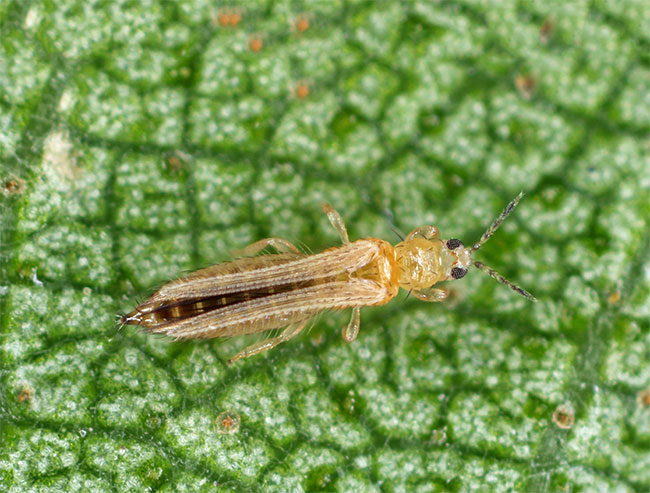
In this industry, it seems like just when we have one thing handled, the Powers That Be throw us something new. Recently, it appears that Western flower thrips (WFT) have decided they aren’t giving us enough of a challenge and have recruited some “friends”. Onion thrips are the most prevalent of these new pest thrips, even outnumbering WFT in some greenhouses. But they aren’t the only ones you need to watch out for.
This new potpourri of thrips species often appears in greenhouses using primarily biocontrol and can cause sudden heavy damage to some of our most common crops. This includes chrysanthemum, gerbera, and spring bedding plants. Although mite-based biocontrol programs generally keep populations of WFT in check, they don’t appear to be working entirely well against this new suite of thrips, which can throw growers for a loop.
The new reality is that growers will likely have to become familiar with these different thrips species to make the best IPM decisions possible, particularly when unusual thrips damage occurs. Consider this your introductory guide to the new thrips on the block for spring bedding crops and beyond.
Where are they coming from?
Research by Dr. Rose Buitenhuis in 2017 (Vineland Research and Innovation Centre) demonstrated that imported cuttings are a main source of both thrips and spider mite issues for Ontario growers. In summer 2019, OMAFRA summer student Elizabeth Huber-Kidby examined weekly shipments of chrysanthemum cuttings from various suppliers to determine exactly which species of thrips arrive in our greenhouses this way. All thrips that emerged from mum cuttings were WFT, with the exception of a single chrysanthemum thrips.
This tells us that onion thrips and other thrips species are most likely coming in through greenhouse vents and other openings and are able to establish in the greenhouse due to low pesticide use. Although, at this point, we can’t entirely rule out cuttings of other non-mum crops as a possible source for some of these thrips species, especially if you grow multiple crops in the same compartment.
How to tell your thrips apart
To tell which thrips are causing damage to your plants, the most definitive way is to collect specimens from damaged plants and look at them under a microscope. Dr. Sarah Jandricic, OMAFRA greenhouse IPM specialist, and Ashley Summerfield a University of Guelph M.Sc. student studying new thrips species, have put together an easy set of diagrams that growers can use to tell common thrips apart with minimal effort. You can find this key and instructions for collecting thrips at http://greenhouseipm.org/pests/thripskey/. The following is a quick introduction to these pests.
Thrips you need to know
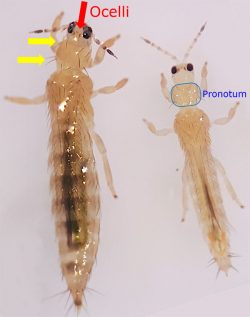
Western flower thrips
Adult female (left) and male (right) western flower thrips. Yellow arrows indicate coarse hairs on the top and bottom of the pronotum. Photo credit: A. Summerfield
Western flower thrips (Frankliniella occidentalis)
Pest status: WFT is still the primary thrips species in most ornamental greenhouses and seem happy living concurrently with other thrips species that may invade.
Key features: Larger than the other yellow-coloured thrips you’ll encounter, WFT have bright red ocelli (3 spots between their eyes). They also have plenty of long coarse hairs on the top and bottom of their “shoulders” (called the pronotum). WFT body colour ranges from common pale yellow to a very dark brown (called a “dark morph”).
Known host crops: Wide host range
Damage pattern: Widespread, dispersed damage in crop; frequently causes damage to flowers
Best ways to monitor: Yellow monitoring cards; plant taps of highly attractive plant varieties.
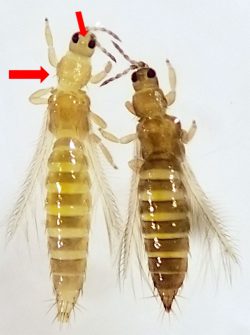
Onion thrips
Light and dark coloured onion thrips (adult females). This variation in body colour illustrates why you should never rely on colour to identify your thrips species.
Onion thrips (Thrips tabaci)
Pest status: Onion thrips is the most prevalent of the “new kids” and has composed up to 80% of the thrips infesting certain crops in Niagara. Present in Ontario for more than a century, they’ve only recently become a concern outside of field crops.
Key features: Pale grey ocelli (eye spots); coarse hairs occur only on the bottom of the pronotum (none on top); their bodies range in colour from pale yellow to brown. Smaller than WFT.
Known host crops: Wide host range; has been problematic in chrysanthemums, gerbera, osteospermums, herbs, cyclamen, impatiens and gloxinia in Ontario so far. If your thrips IPM program isn’t working in a different crop, suspect that it may be onion thrips and have them identified.
Damage pattern: Crops damaged in small clusters of plants; heavy damage to the foliage that makes the plant unsellable; less damage to flowers
Best ways to monitor: Yellow monitoring cards and plant taps of highly damaged plants.
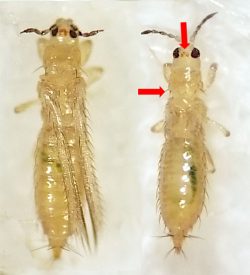
Chrysanthemum thrips
Winged (left) and wingless (right) chrysanthemum thrips (adult females).
Chrysanthemum thrips (Thrips nigropilosus)
Pest status: Generally unknown, but have caused damage to several chrysanthemum operations to date in Niagara.
Key features: This species has both winged and wingless forms. At first glance, the winged morphs look a lot like WFT but are smaller in size. They have bright red ocelli and no coarse hairs on the top of the pronotum; typically yellow in colour.
Known host crops: As the name implies, their primary host is chrysanthemum, but they’ve also been found in marigolds and verbena.
Damage pattern: Unknown
Best ways to monitor: Plant taps, due to the presence of a wingless form.
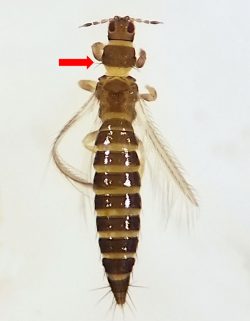
Tobacco thrips
Winged tobacco thrips (adult female). Photo credit: A. Summerfield
Tobacco thrips (Frankliniella fusca)
Pest status: Tobacco thrips have been very common in our surveys, although typically only at low numbers. Their actual pest status is unclear at this time.
Key features: As with chrysanthemum thrips, tobacco thrips have a wingless form that is induced by short photoperiods. They are medium to dark brown in colour, meaning their red ocelli are difficult to see. Like WFT, they have coarse hairs on the top and bottom of the pronotum. It is difficult to tell the difference between tobacco thrips and dark morphs of WFT. In our samples from the Niagara region, dark brown thrips have almost always been tobacco thrips.
Known host crops: Although reported to have a wide host range, this is poorly characterized in ornamental crops
Damage pattern: Unknown
Best ways to monitor: Until we are sure that these are actually causing damage, there is no need to monitor for them specifically. However, if you see a lot of “dark” WFT on yellow trap cards in the spring and summer, have them identified before you assume WFT numbers are high in your crop.
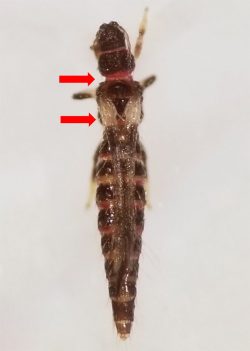
Echinothrips
Echinothrips (adult female). Photo credit: A. Summerfield
Echinothrips (Echinothrips americanus)
Pest status: Echinothrips can be a serious pest for several crops. Since this species does not pupate in the soil, soil-dwelling biocontrol agents (e.g. nematodes, Dalotia and predatory mites) aren’t effective, and control can be difficult.
Key features: Dark brown to black in colour, with highly visible white patches at the base of the wings on live insects. However, this feature isn’t visible on Echinothrips caught on sticky cards or if samples are placed in liquid. Echinothrips also have distinctive orangey-red pigmentation between their body segments. They have no coarse hairs on top of the pronotum.
Known host crops: Poinsettia, gerbera, impatiens, cyclamen, alstroemeria and dieffenbachia are common host plants in Ontario.
Damage pattern: Foliar damage; rarely found in flowers.
Best ways to monitor: Use small (e.g. 3 cm2) square cut-outs of blue monitoring cards placed horizontally on the leaf surface, since this species doesn’t leave the foliage much.
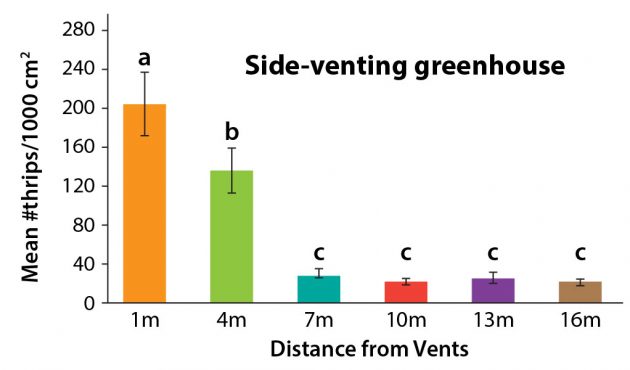
Thrips caught on sticky traps in a side-venting greenhouse. Only distance from the vents affected catch numbers; colour of the trap was not significant. Image credit: OMAFRA
Control options
Besides WFT, onion thrips are the main species you’ll have to worry about this year. Large mass trapping cards or sticky tape should be an integral part of your IPM program. These help intercept incoming thrips in the spring and summer months. Anything that helps reduce the numbers of these emerging pests and prevents establishment in your greenhouse is helpful at this point. Both WFT and onion thrips are more attracted to yellow than blue mass traps, as confirmed in 2019 tests held in top-venting greenhouses.
However, in side-venting greenhouses, 2016 studies showed the vast majority of card captures occur within a few meters of the vents (see graph). To reduce thrips fly-ins, mass trappings should be more effective in side-venting greenhouses than top-venting ones, especially if cards are concentrated near the vents. Having the cards face the vents (rather than be perpendicular to them) may also increase catches.
As for biocontrol options, we’re still figuring out which products (e.g. nematodes, predatory mites, predatory bugs, microbial pesticides) work best against these new thrips pests. Until then, growers have seen some success with pesticides registered for thrips that don’t normally work on the highly insecticide-resistant WFT. However, in other cropping systems, species like the onion thrips have also shown an ability to become highly resistant to chemical products. Future research on effective biocontrol or cultural control tactics will be key to managing the complex of thrips species we now have to battle.
Acknowledgements: This research was supported by the Canadian Greenhouse Conference.
Sarah Jandricic, PhD, is the greenhouse floriculture IPM specialist for OMAFRA. Ashley Summerfield is an M.Sc. student in the Environmental Sciences Department at the University of Guelph. Her co-advisors on the onion thrips project are Rose Buitenhuis, PhD, (Biocontrol Lab; Vineland Research and Innovation Centre) and Cynthia Scott-Dupree, PhD, (Professor and Bayer Crop Science Chair in Sustainable Pest Management).
Print this page